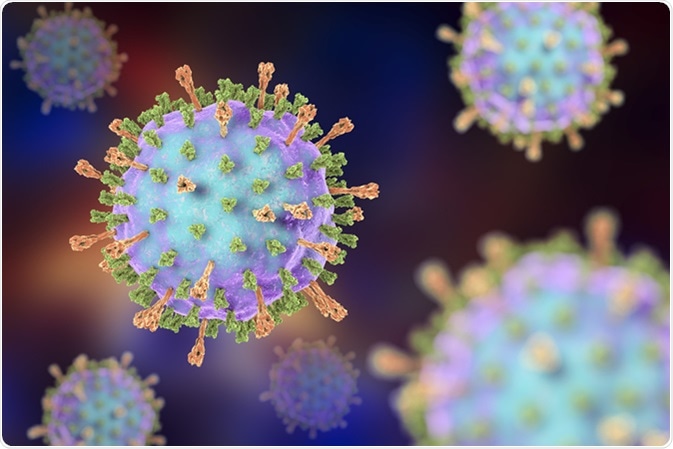According to a federal experts panel yesterday (25th October 2017), a third dose of mumps vaccine is recommended when there is an outbreak of the viral disease. There have been several mumps outbreaks since 2006 in the United States, especially among students who have already been vaccinated before. Last year 6366 cases of the highly infectious viral infection were reported in the United States.
The year before it was much less at 1329 in 2015. This year till date, around 4600 cases have been recorded. This is one of the highest incidences of this disease in the past 10 years.

Mumps virus. 3D illustration - Image Credit: Kateryna Kon / Shutterstock
One of the differences in mumps outbreaks from measles and whopping cough outbreaks is that the latter two infections are seen among those who have not received any vaccination previously. Mumps is seen to occur even among those who have been vaccinated. At present according to the Centers for Disease Control and Prevention, CDC, all children must receive two doses of the MMR vaccine. The MMR vaccine contains shots against measles, mumps and rubella. The first dose is recommended at 12 to 15 months of age and the second at 4 to 6 years of age.
Until now this was enough to provide immunity against mumps infection. Yesterday the Advisory Committee on Immunization Practices at their meeting noted that this immunity wanes with years and leaves the individual vulnerable to the infection later in life. The third booster shot was not recommended for all individuals. The committee voted unanimously in favor of administration of the third dose of mumps vaccine in persons who would later be public health officials and would be exposed to the infection especially during an outbreak. The CDC usually adopts the recommendations made the committee.
Mumps and its Outbreaks
Mumps is a viral infection caused by a paramyxovirus. The symptoms begin to appear after around two weeks of coming in contact with an infected person. It is highly contagious. The infection spreads through contact with saliva or mucus of an infected person. Coughing, sneezing, sharing utensils and touching surfaces that have been touched or used with unwashed hands of infected persons can all lead to spread of this infection.
The typical presentation of mumps is puffiness of the cheeks and swollen angles of the jaws. This is caused due to swelling of the salivary glands. There is pain on swallowing and accompanying high fever, headache, body ache and loss of appetite. There is pain on speaking and ear pain as well. Most people with mumps recover within a few weeks. Some individuals may develop complications of mumps such as encephalitis, or meningitis (brain infections), swelling and inflammation of the testes and ovaries, hearing loss and inflammation of the pancreas. If the infection is caught by a woman in the first three months of her pregnancy, she is likely to lose her baby to a miscarriage.
Between January 2016 and June 2017, over 9000 people have been reported to have developed mumps in the US. Around one in two cases are college students. Of these 70 percent had received the vaccination for mumps previously. Syracuse University at present is experiencing an outbreak of mumps since August this year. The students there would be offered a third booster does of the vaccine. There are 27 confirmed cases there who have all been vaccinated previously with two doses of the vaccine.
Reference: https://www.cdc.gov/mumps/hcp.html